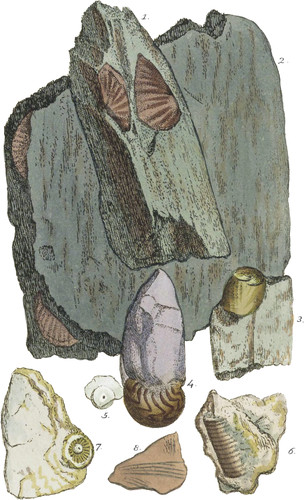 Enlarge
Enlarge
British Mineralogy
Greywacke and Greywacke Slate of Geologists
Transition Slate of some consists of granules of Quartz, fragments of Slate, &c.* cemented together by a clayey talcose or micaceous paste; the granules are often large, the cement rough, and the general structure of the rock compact; at other times the granules are minute and the paste smooth, approaching in appearance to Hornstone, and in large columnar concretions; when the granules are small and the paste has a ragged fracture the rock is generally of a slaty structure; this last variety is the most remarkable, because it contains sometimes the remains of animal exuvia: I have, therefore, given several figures of it.
The columnar Wacke, of which I have specimens from Coniston, is distinguishable from Basalt, not only in its composition and colour, but by the form of its columns, without joints and ragged on their sides, as if they had shrunk from each other; they are about four feet long, mostly four-sided, three or four inches square, and very sonorous.
In the year 1799, although scarcely attending to the subject, I could not help noticing the Limestone and Slate near Plymouth, passing almost imperceptibly into each other in some places, and in others very distinct and alternating. I have ever since desired to get proper specimens to elucidate this, but have been interrupted: fortunately, however, the Rev. William Buckland has lent me two or three very interesting pieces with the following label:—“From Lord Fortescue’s quarries of Transition Limestone, at Filliagh, near Southmoulton, Devonshire: the Lime forms subordinate beds, alternating with coarse Slate, of which a fragment, accompanies the shell; fragments of the stem of an Encrinus occur, though sparingly, in the same slate: the position of which is for the most part vertical, but varies to a wedge shape, Saddle shape, II erring-bone, &c. The Lime sometimes appears in the form of a vertical bed of large lenticular calcareous concretions. Organic remains are very scarce.” One of these is an Ammonite, formed of Carbonate of Lime with a little pyrites, very similar to, if not precisely the same as A. sphæricus, Mineral Conchology, tab. 53. fig. 2.—another, an Enerinus of the same kind as occurs in the Transition Limestone, that accompanies the Greywacke Schist, (see fig. 4.) Fig. 5 exhibits the cast of an Enerinusin Carbonate of Lime imbedded in Schist, from Mount Sion, Docks, Plymouth: thus forming a link between the Limestone and Schist; I have a specimen from Glyn Duffus, containing impressions only of a species of the Genus Spirifer (Anomia) and a minute Trilobite, in which the Lime is so incorporated with the Schist as to effervesce but slowly in acids. The other specimens figured are of a coarser browner kind from rocks, that do not, as I know of, contain any Limestone, and are probably of an earlier formation than those of Plymouth, but not so old as those of a less slaty structure.
Fig. 1 is a fragment, of a rather columnar shape from the summit of Snowdon: it is nearly the same variety as a prismatic mass, 7 feet 5 inches long, several inches square, and covered with impressions of shells brought from Tintagel in Cornwall to our Geological Society’s collection: the shells impressed in these, I find from their general form, belong to the new Genus Spiriler, which I have separated from the Terebratula of modern authors, a genus of shells common in the oldest Limestones, such as those of Derbyshire. Fig. 2. a more slaty specimen, from the same place, gathered by Richard Cotton, esq.
Fig. 3. is very remarkable for containing the cast of part of a spiral univalve, but it is to be regretted that there is not enough of it to mark even the genus. I am indebted to Miss Leach for it, wiio collected it on Snowdon. Many of the casts in these Snowdon specimens are replete with a brown ochraceous matter, which burns like powdery Charcoal.
- * Some, apparently recent rejectnmenta of the rocks, returned and hardened on the shore at Ilfracomb, resemble these.

